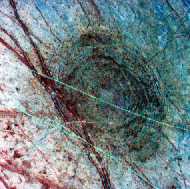This image shows the crater Pwyll on Europa, a moon of Jupiter. Do you see the pattern of concentric circles? This pattern is not typical of craters on Earth except for the newly discovered crater in the North Sea.
Click on image for full size
Courtesy of NASA
A Crater on Earth that Looks out of this World!
News story originally written on August 14, 2002
Scientists studying the rock layers that lie under the North Sea have found a mysterious crater that looks more like craters on Europa and Callisto, icy moons of Jupiter, than craters on Earth.
The crater, called Silverpit, is under layers of rock in the North Sea, about 200 miles from the eastern coast of England. It is twelve miles (20 km) wide and has large concentric rings. A massive meteor about 400 feet across and weighing over 2 million tons would be needed to form a crater this large.
The odd shape of the crater, with its concentric rings, is puzzling to scientists who believe it looks much more like the craters on Europa and Castillo than craters on Earth. This gives scientists an opportunity to, while staying close to home, learn more about how craters form with these unique shapes. According to Jay Melosh, a planetary scientist at the University of Arizona, “Silverpit is likely to teach us a great deal about the mechanics of how such ring systems arise.”
The crater also interests scientists because its age. It is 60-65 million years old, which is similar to the age of the Chicxulub meteor impact that produced a climate change causing dinosaurs and many other living things to become extinct. Whether the newly discovered Silverpit crater is related to the extinction is unknown and more research is needed to examine this.
Last modified August 14, 2002 by Lisa Gardiner.
You might also be interested in:

Europa was first discovered by Galileo in 1610, making it one of the Galilean Satellites. It is Jupiter's 4th largest moon, 670,900 km from Jupiter. With a diameter that is about half the distance across
...more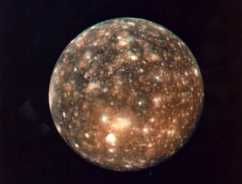
Callisto was first discovered by Galileo in 1610, making it one of the Galilean Satellites. Of the 60 moons it is the 8th closest to Jupiter, with a standoff distance of 1,070,000 km. It is the 2nd largest
...more
It was another exciting and frustrating year for the space science program. It seemed that every step forward led to one backwards. Either way, NASA led the way to a great century of discovery. Unfortunately,
...more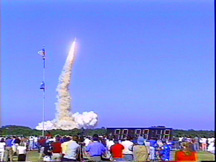
The Space Shuttle Discovery lifted off from Kennedy Space Center on October 29th at 2:19 p.m. EST. The weather was great as Discovery took 8 1/2 minutes to reach orbit. This was the United States' 123rd
...more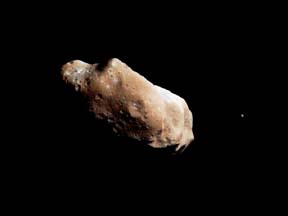
A moon was discovered orbiting the asteroid, Eugenia. This is only the second time in history that a satellite has been seen circling an asteroid. A special mirror allowed scientists to find the moon
...more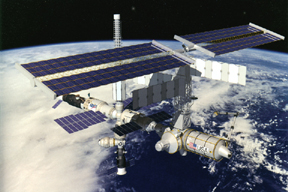
Will Russia ever put the service module for the International Space Station in space? NASA officials want an answer from the Russian government. The necessary service module is currently waiting to be
...more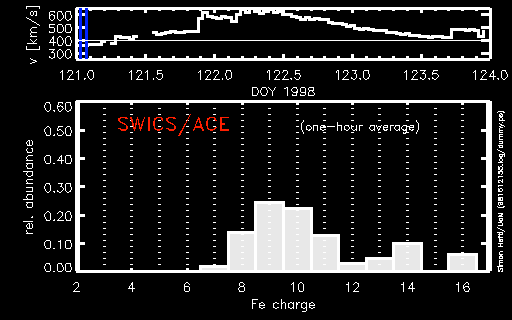
A coronal mass ejection (CME) happened on the Sun early last month. The material that was thrown out from this explosion passed the ACE spacecraft. The SWICS instrument on ACE has produced a new and very
...more


